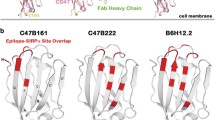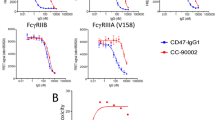Abstract
CD47, an immune checkpoint receptor frequently unregulated in various blood and solid tumors, interacts with ligand SIPRα on innate immune cells, and conveys a “do not eat me” signal to inhibit macrophage-mediated tumor phagocytosis. This makes CD47 a valuable target for cancer immunotherapy. However, the therapeutic utility of CD47-SIRPα blockade monoclonal antibodies is largely compromised due to significant red blood cell (RBCs) toxicities and fast target-mediated clearance as a result of extensive expression of CD47 on normal cells. To overcome these limitations and further improve therapeutic efficacy, we designed IBI322, a CD47/PD-L1 bispecific antibody which attenuated CD47 activity in monovalent binding and blocked PD-L1 activity in bivalent binding. IBI322 selectively bound to CD47+PD-L1+ tumor cells, effectively inhibited CD47-SIRPα signal and triggered strong tumor cell phagocytosis in vitro, but only with minimal impact on CD47 single positive cells such as human RBCs. In addition, as a dual blocker of innate and adaptive immune checkpoints, IBI322 effectively accumulated in PD-L1-positive tumors and demonstrated synergistic activity in inducing complete tumor regression in vivo. Furthermore, IBI322 showed only marginal RBCs depletion and was well tolerated in non-human primates (NHP) after repeated weekly injections, suggesting a sufficient therapeutic window in future clinical development of IBI322 for cancer treatment.







Similar content being viewed by others
Abbreviations
- ATCC:
-
American Type Culture Collection
- DCs:
-
Dendritic cells
- DFO:
-
P-SCN-Deferoxamine
- IBI322:
-
An anti-CD47/PD-L1 bispecific antibody
- NHPs:
-
Non-human primates
- PD-L1:
-
Programmed death-ligand 1
- PD-1:
-
Programmed death-1
- RBCs:
-
Red blood cells
- SIRPα:
-
Signal-regulatory protein-α
References
Brown EJ, Frazier WA (2001) Integrin-associated protein (CD47) and its ligands. Trends Cell Biol 11(3):130–135. https://doi.org/10.1016/S0962-8924(00)01906-1
Barclay AN, Berg TKVD (2014) The interaction between signal regulatory protein alpha (SIRPα) and CD47: structure, function, and therapeutic target. Annu Rev Immunol 32(1):25–50. https://doi.org/10.1146/annurev-immunol-032713-120142
Majeti R, Chao MP, Alizadeh AA, Pang WW, Jaiswal S, Gibbs KD Jr, van Rooijen N, Weissman IL (2009) CD47 is an adverse prognostic factor and therapeutic antibody target on human acute myeloid leukemia stem cells. Cell 138(2):286–299. https://doi.org/10.1016/j.cell.2009.05.045
Jaiswal S, Jamieson CHM, Pang WW, Park CY, Chao MP, Majeti R, Traver D, van Rooijen N, Weissman IL (2009) CD47 is upregulated on circulating hematopoietic stem cells and leukemia cells to avoid phagocytosis. Cell 138(2):271–285. https://doi.org/10.1016/j.cell.2009.05.046
Chao MP, Alizadeh AA, Tang C, Myklebust JH, Varghese B, Gill S, Jan M, Cha AC, Chan CK, Tan BT, Park CY, Zhao F, Kohrt HE, Malumbres R, Briones J, Gascoyne RD, Lossos IS, Levy R, Weissman IL, Majeti R (2010) Anti-CD47 antibody synergizes with rituximab to promote phagocytosis and eradicate non-hodgkin lymphoma. Cell 142(5):699–713. https://doi.org/10.1016/j.cell.2010.07.044
Willingham SB, Volkmer J-P, Gentles AJ, Sahoo D, Dalerba P, Mitra SS, Wang J, Contreras-Trujillo H, Martin R, Cohen JD, Lovelace P, Scheeren FA, Chao MP, Weiskopf K, Tang C, Volkmer AK, Naik TJ, Storm TA, Mosley AR, Edris B, Schmid SM, Sun CK, Chua M-S, Murillo O, Rajendran P, Cha AC, Chin RK, Kim D, Adorno M, Raveh T, Tseng D, Jaiswal S, Enger PØ, Steinberg GK, Li G, So SK, Majeti R, Harsh GR, van de Rijn M, Teng NNH, Sunwoo JB, Alizadeh AA, Clarke MF, Weissman IL (2012) The CD47-signal regulatory protein alpha (SIRPa) interaction is a therapeutic target for human solid tumors. Proc Natl Acad Sci 109(17):6662–6667. https://doi.org/10.1073/pnas.1121623109
Advani R, Flinn I, Popplewell L, Forero A, Bartlett NL, Ghosh N, Kline J, Roschewski M, LaCasce A, Collins GP, Tran T, Lynn J, Chen JY, Volkmer J-P, Agoram B, Huang J, Majeti R, Weissman IL, Takimoto CH, Chao MP, Smith SM (2018) CD47 blockade by Hu5F9-G4 and rituximab in non-Hodgkin’s lymphoma. N Engl J Med 379(18):1711–1721. https://doi.org/10.1056/NEJMoa1807315
Sallman DA, Donnellan WB, Asch AS, Lee DJ, Malki MA, Marcucci G, Pollyea DA, Kambhampati S, Komrokji RS, Elk JV, Lin M, Agoram B, Chen JY, Volkmer J-P, Takimoto CHM, Chao M, Vyas P (2019) The first-in-class anti-CD47 antibody Hu5F9-G4 is active and well tolerated alone or with azacitidine in AML and MDS patients: initial phase 1b results. J Clin Oncol 37:7009–7009. https://doi.org/10.1200/JCO.2019.37.15_suppl.7009
Sikic BI, Lakhani N, Patnaik A, Shah SA, Chandana SR, Rasco D, Colevas AD, O’Rourke T, Narayanan S, Papadopoulos K, Fisher GA, Villalobos V, Prohaska SS, Howard M, Beeram M, Chao MP, Agoram B, Chen JY, Huang J, Axt M, Liu J, Volkmer J-P, Majeti R, Weissman IL, Takimoto CH, Supan D, Wakelee HA, Aoki R, Pegram MD, Padda SK (2019) First-in-human, first-in-class phase I trial of the anti-cd47 antibody Hu5F9-G4 in patients with advanced cancers. J Clin Oncol 37(12):946–953. https://doi.org/10.1200/jco.18.02018
Liu B, Guo H, Xu J, Qin T, Guo Q, Gu N, Zhang D, Qian W, Dai J, Hou S, Wang H, Guo Y (2018) Elimination of tumor by CD47/PD-L1 dual-targeting fusion protein that engages innate and adaptive immune responses. m Abs 10(2):315–324. https://doi.org/10.1080/19420862.2017.1409319
Lian S, Xie R, Ye Y, Lu Y, Cheng Y, Xie X, Li S, Jia L (2019) Dual blockage of both PD-L1 and CD47 enhances immunotherapy against circulating tumor cells. Sci Rep 9(1):4532. https://doi.org/10.1038/s41598-019-40241-1
Liu X, Liu L, Ren Z, Yang K, Xu H, Luan Y, Fu K, Guo J, Peng H, Zhu M, Fu Y-X (2018) Dual targeting of innate and adaptive checkpoints on tumor cells limits immune evasion. Cell Rep 24(8):2101–2111. https://doi.org/10.1016/j.celrep.2018.07.062
Chen L, Han X (2015) Anti–PD-1/PD-L1 therapy of human cancer: past, present, and future. J Clin Investig 125(9):3384–3391. https://doi.org/10.1172/JCI80011
Sanmamed MF, Chen L (2018) A paradigm shift in cancer immunotherapy: from enhancement to normalization. Cell 175(2):313–326. https://doi.org/10.1016/j.cell.2018.09.035
Brahmer JR, Tykodi SS, Chow LQM, Hwu W-J, Topalian SL, Hwu P, Drake CG, Camacho LH, Kauh J, Odunsi K, Pitot HC, Hamid O, Bhatia S, Martins R, Eaton K, Chen S, Salay TM, Alaparthy S, Grosso JF, Korman AJ, Parker SM, Agrawal S, Goldberg SM, Pardoll DM, Gupta A, Wigginton JM (2012) Safety and activity of anti–PD-L1 antibody in patients with advanced cancer. N Engl J Med 366(26):2455–2465. https://doi.org/10.1056/NEJMoa1200694
Wilky BA (2019) Immune checkpoint inhibitors: The linchpins of modern immunotherapy. Immunol Rev 290(1):6–23. https://doi.org/10.1111/imr.12766
Topalian SL, Hodi FS, Brahmer JR, Gettinger SN, Smith DC, McDermott DF, Powderly JD, Carvajal RD, Sosman JA, Atkins MB, Leming PD, Spigel DR, Antonia SJ, Horn L, Drake CG, Pardoll DM, Chen L, Sharfman WH, Anders RA, Taube JM, McMiller TL, Xu H, Korman AJ, Jure-Kunkel M, Agrawal S, McDonald D, Kollia GD, Gupta A, Wigginton JM, Sznol M (2012) Safety, activity, and immune correlates of Anti–PD-1 antibody in cancer. N Engl J Med 366(26):2443–2454. https://doi.org/10.1056/NEJMoa1200690
Brahmer JR, Drake CG, Wollner I, Powderly JD, Picus J, Sharfman WH, Stankevich E, Pons A, Salay TM, McMiller TL, Gilson MM, Wang C, Selby M, Taube JM, Anders R, Chen L, Korman AJ, Pardoll DM, Lowy I, Topalian SL (2010) Phase I study of single-agent anti-programmed death-1 (MDX-1106) in refractory solid tumors: safety, clinical activity, pharmacodynamics, and immunologic correlates. J Clin Oncol 28(19):3167–3175. https://doi.org/10.1200/jco.2009.26.7609
Gordon SR, Maute RL, Dulken BW, Hutter G, George BM, McCracken MN, Gupta R, Tsai JM, Sinha R, Corey D, Ring AM, Connolly AJ, Weissman IL (2017) PD-1 expression by tumour-associated macrophages inhibits phagocytosis and tumour immunity. Nature 545(7655):495–499. https://doi.org/10.1038/nature22396
Merchant AM, Zhu Z, Yuan JQ, Goddard A, Adams CW, Presta LG, Carter P (1998) An efficient route to human bispecific IgG. Nat Biotechnol 16(7):677–681. https://doi.org/10.1038/nbt0798-677
Wang J, Fei K, Jing H, Wu Z, Wu W, Zhou S, Ni H, Chen B, Xiong Y, Liu Y, Peng B, Yu D, Jiang H, Liu J (2019) Durable blockade of PD-1 signaling links preclinical efficacy of sintilimab to its clinical benefit. Am Abs 11(8):1443–1451. https://doi.org/10.1080/19420862.2019.1654303
England CG, Ehlerding EB, Hernandez R, Rekoske BT, Graves SA, Sun H, Liu G, McNeel DG, Barnhart TE, Cai W (2017) Preclinical pharmacokinetics and biodistribution studies of 89Zr-labeled pembrolizumab. J Nucl Med 58(1):162–168. https://doi.org/10.2967/jnumed.116.177857
Tavare R, Escuin-Ordinas H, Mok S, McCracken MN, Zettlitz KA, Salazar FB, Witte ON, Ribas A, Wu AM (2016) An effective immuno-PET imaging method to monitor CD8-dependent responses to immunotherapy. Cancer Res 76(1):73–82. https://doi.org/10.1158/0008-5472.CAN-15-1707
Chao MP, Majeti R, Weissman IL (2012) Programmed cell removal: a new obstacle in the road to developing cancer. Nat Rev Cancer 12(1):58–67. https://doi.org/10.1038/nrc3171
Wu L, Yu G-T, Deng W-W, Mao L, Yang L-L, Ma S-R, Bu L-L, Kulkarni AB, Zhang W-F, Zhang L, Sun Z-J (2018) Anti-CD47 treatment enhances anti-tumor T-cell immunity and improves immunosuppressive environment in head and neck squamous cell carcinoma. OncoImmunology 7(4):e1397248. https://doi.org/10.1080/2162402X.2017.1397248
Liu J, Wang L, Zhao F, Tseng S, Narayanan C, Shura L, Willingham S, Howard M, Prohaska S, Volkmer J, Chao M, Weissman IL, Majeti R (2015) Pre-clinical development of a humanized anti-CD47 antibody with anti-cancer therapeutic potential. PLoS ONE 10(9):e0137345. https://doi.org/10.1371/journal.pone.0137345
Casey SC, Tong L, Li Y, Do R, Walz S, Fitzgerald KN, Gouw AM, Baylot V, Gütgemann I, Eilers M, Felsher DW (2016) MYC regulates the antitumor immune response through CD47 and PD-L1. Science 352(6282):227–231. https://doi.org/10.1126/science.aac9935
Funding
This work was financially supported by the National Significant New Drugs Creation Program (2017ZX09304021), Jiangsu Provincial Medical Innovation Team (CXTDA2017024), and Leading technology foundation research project of Jiangsu province (BK20192005).
Author information
Authors and Affiliations
Contributions
YW, HN, SZ, BC, MY, LM and JL designed the study; HN, YG, SZ, WW and ZW performed the in vitro experiment; WW, MW, YZ, BC, YW, DP, CH, ML, and YB performed the in vivo experiment and biodistribution; XQ performed the experiment in primate. HN, SZ, KH and JL wrote the manuscript. All authors read and approved the final manuscript.
Corresponding authors
Ethics declarations
Conflict of interest
Haiqing Ni, Shuaixiang Zhou, Kaijie He, Yarong Gao, Weiwei Wu, Min Wu, Zhihai Wu, Xuan Qiu, ying Zhou, Bingliang Chen, and Junjian Liu are employees of Innovent Biologics (Suzhou). All the remaining authors have declared no conflicts of interest.
Ethical approval
All mice experiments were performed in accordance with the regulations for care and use of laboratory animals at Innovent Biologics and were approved by Innovent’s Institutional Animal Care and Use Committee (IACUC-01). All monkey experiments were approved by IACUC and performed according to the regulation of AAALAC.
Animal source
NOS-SCID mice and NOG mice were purchased from Beijing Vital River Laboratory Animal Technology Co., Ltd. (Beijing, China). Human CD47 knock-in mice were purchased from Biocytogen, Inc. (Beijing, China). Cynomolgus monkeys were purchased from Beijing Prima Biotech Inc.
Cell line authentication
RAJI, A375, CCRF-CEM, and H292 cell lines were obtained from ATCC (Manassas, VA). CHO-S cell line was obtained from Themo Fisher Scientific, Carlsbad, CA, USA). MC38 cell line was obtained from Shanghai Model Organisms Center, Inc. (Shanghai, China). PBMC cells were purchased from Allcells (Alameda, CA, USA).
Additional information
Publisher's Note
Springer Nature remains neutral with regard to jurisdictional claims in published maps and institutional affiliations.
Yan Wang, Haiqing Ni and Shuaixiang Zhou contributed equally to this work.
Electronic supplementary material
Below is the link to the electronic supplementary material.
Rights and permissions
About this article
Cite this article
Wang, Y., Ni, H., Zhou, S. et al. Tumor-selective blockade of CD47 signaling with a CD47/PD-L1 bispecific antibody for enhanced anti-tumor activity and limited toxicity. Cancer Immunol Immunother 70, 365–376 (2021). https://doi.org/10.1007/s00262-020-02679-5
Received:
Accepted:
Published:
Issue Date:
DOI: https://doi.org/10.1007/s00262-020-02679-5




